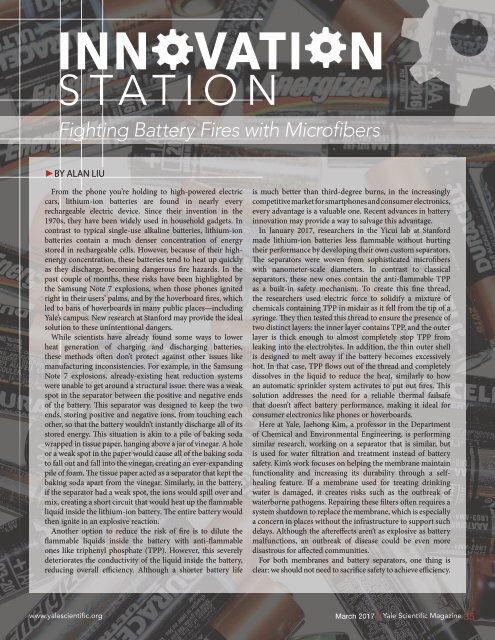YSM Issue 90.2
Create successful ePaper yourself
Turn your PDF publications into a flip-book with our unique Google optimized e-Paper software.
INN VATI N<br />
STATION<br />
Fighting Battery Fires with Microfibers<br />
►BY ALAN LIU<br />
From the phone you’re holding to high-powered electric<br />
cars, lithium-ion batteries are found in nearly every<br />
rechargeable electric device. Since their invention in the<br />
1970s, they have been widely used in household gadgets. In<br />
contrast to typical single-use alkaline batteries, lithium-ion<br />
batteries contain a much denser concentration of energy<br />
stored in rechargeable cells. However, because of their highenergy<br />
concentration, these batteries tend to heat up quickly<br />
as they discharge, becoming dangerous fire hazards. In the<br />
past couple of months, these risks have been highlighted by<br />
the Samsung Note 7 explosions, when those phones ignited<br />
right in their users’ palms, and by the hoverboard fires, which<br />
led to bans of hoverboards in many public places—including<br />
Yale’s campus. New research at Stanford may provide the ideal<br />
solution to these unintentional dangers.<br />
While scientists have already found some ways to lower<br />
heat generation of charging and discharging batteries,<br />
these methods often don’t protect against other issues like<br />
manufacturing inconsistencies. For example, in the Samsung<br />
Note 7 explosions, already-existing heat reduction systems<br />
were unable to get around a structural issue: there was a weak<br />
spot in the separator between the positive and negative ends<br />
of the battery. This separator was designed to keep the two<br />
ends, storing positive and negative ions, from touching each<br />
other, so that the battery wouldn’t instantly discharge all of its<br />
stored energy. This situation is akin to a pile of baking soda<br />
wrapped in tissue paper, hanging above a jar of vinegar. A hole<br />
or a weak spot in the paper would cause all of the baking soda<br />
to fall out and fall into the vinegar, creating an ever-expanding<br />
pile of foam. The tissue paper acted as a separator that kept the<br />
baking soda apart from the vinegar. Similarly, in the battery,<br />
if the separator had a weak spot, the ions would spill over and<br />
mix, creating a short circuit that would heat up the flammable<br />
liquid inside the lithium-ion battery. The entire battery would<br />
then ignite in an explosive reaction.<br />
Another option to reduce the risk of fire is to dilute the<br />
flammable liquids inside the battery with anti-flammable<br />
ones like triphenyl phosphate (TPP). However, this severely<br />
deteriorates the conductivity of the liquid inside the battery,<br />
reducing overall efficiency. Although a shorter battery life<br />
is much better than third-degree burns, in the increasingly<br />
competitive market for smartphones and consumer electronics,<br />
every advantage is a valuable one. Recent advances in battery<br />
innovation may provide a way to salvage this advantage.<br />
In January 2017, researchers in the Yicui lab at Stanford<br />
made lithium-ion batteries less flammable without hurting<br />
their performance by developing their own custom separators.<br />
The separators were woven from sophisticated microfibers<br />
with nanometer-scale diameters. In contrast to classical<br />
separators, these new ones contain the anti-flammable TPP<br />
as a built-in safety mechanism. To create this fine thread,<br />
the researchers used electric force to solidify a mixture of<br />
chemicals containing TPP in midair as it fell from the tip of a<br />
syringe. They then tested this thread to ensure the presence of<br />
two distinct layers: the inner layer contains TPP, and the outer<br />
layer is thick enough to almost completely stop TPP from<br />
leaking into the electrolytes. In addition, the thin outer shell<br />
is designed to melt away if the battery becomes excessively<br />
hot. In that case, TPP flows out of the thread and completely<br />
dissolves in the liquid to reduce the heat, similarly to how<br />
an automatic sprinkler system activates to put out fires. This<br />
solution addresses the need for a reliable thermal failsafe<br />
that doesn’t affect battery performance, making it ideal for<br />
consumer electronics like phones or hoverboards.<br />
Here at Yale, Jaehong Kim, a professor in the Department<br />
of Chemical and Environmental Engineering, is performing<br />
similar research, working on a separator that is similar, but<br />
is used for water filtration and treatment instead of battery<br />
safety. Kim’s work focuses on helping the membrane maintain<br />
functionality and increasing its durability through a selfhealing<br />
feature. If a membrane used for treating drinking<br />
water is damaged, it creates risks such as the outbreak of<br />
waterborne pathogens. Repairing these filters often requires a<br />
system shutdown to replace the membrane, which is especially<br />
a concern in places without the infrastructure to support such<br />
delays. Although the aftereffects aren’t as explosive as battery<br />
malfunctions, an outbreak of disease could be even more<br />
disastrous for affected communities.<br />
For both membranes and battery separators, one thing is<br />
clear: we should not need to sacrifice safety to achieve efficiency.<br />
www.yalescientific.org<br />
March 2017<br />
Yale Scientific Magazine<br />
35


















